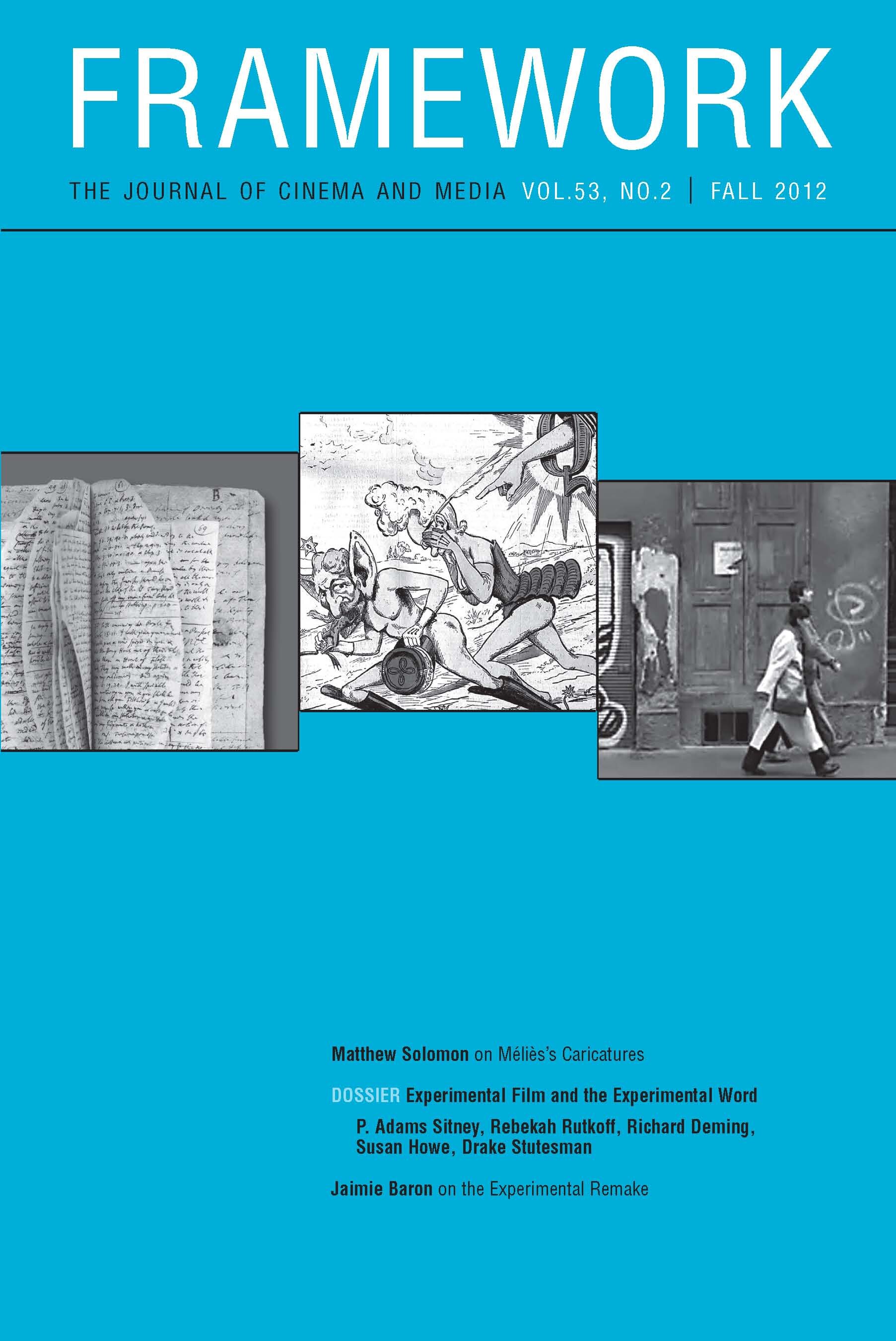53.2
CONTENTS
Drake Stutesman
Editorial
Matthew Solomon
Georges Méliès: Anti-Boulangist Caricature and the Incohérent Movement
Jaimie Baron
The Experimental Film Remake and the Digital Archive Effect: A Movie by Jen Proctor and Man with a Movie Camera: The Global Remake
DOSSIER
Experimental Film and the Experimental Word
P. Adams Sitney
Markopoulos and the Temenos
Rebekah Rutkoff
Small Books about God: The American Artistry of Jonathan Edwards and Robert Beavers
Richard Deming
A Cinematic Alchemy: Lawrence Jordan and the Palimpsest of Cinema
Susan Howe
Sorting Facts; or, Nineteen Ways of Looking at Marker
Drake Stutesman
Without Words, What Are Facts?: Looking at Susan Howe Looking at Marker
EDITORIAL
This issue is devoted to transitions of one medium’s flow into another, with a focus on the experimenting talents of Gregory Markopolous, Robert Beavers, Susan Howe, Lawrence Jordan, Georges Méliès, Bruce Conner, and Jen Proctor.
The work of these artists burgeons and interacts with ideas of others, especially around concepts of form and perceptions of the presentation of form. Matthew Solomon uncovers influences inset in Georges Méliès’s newspaper caricatures, which were made during an era when satirical cartoons were one of the strongest modalities for political comment and political clout. Solomon shows how the multimedia, avant-garde movement of the day, L’Incohérent, suffused Méliès’s drawing. The dossier, Experimental Film and the Experimental Word, weaves work of the image-making writer with that of the literarily driven filmmaker. P. Adams Sitney reveals that the voluptuous films of Gregory Markopolous, rarely screened in the United States, were underpinned by complex internal structures, such as the sound patterns of ancient Greek poetry. Rebekah Rutkoff compares the dense, eloquent writing and handmade books of eighteenth-century American preacher and theologian Jonathan Edwards with the hands-on work of filmmaker Robert Beavers (Markopolous’s partner of many decades). Richard Deming follows the multiple constructions of poetry embedded in the films of Lawrence Jordan. I examine the elliptical, elegiac, personal exegesis on film and mourning by poet Susan Howe in her essay “Sorting Facts; or, Nineteen Ways of Looking at Marker” (reprinted, in Framework 53-2, for the first time since its 1996 publication in Beyond Document). With wit and detail, Jaimie Baron matches the digital “copy” with the celluloid prototype. Baron uses the rich examples of A Movie by Jen Proctor (US, 2010)—Proctor’s remake of Bruce Connor’s 1958 A Movie (US)—and the online project of Perry Bard—Man with a Movie Camera: The Global Remake, begun in 2008—which re/creates daily versions of Dziga Vertov’s Man with a Movie Camera (USSR, 1929). She argues that these kinds of “remakes” open new ways to discuss the inter-relationships of digital and film media and how they—together and separately—“mediate” our experience of the world.
Paul Willemen, one of Framework’s founders and editors, died May 13, 2012. His ideas were a force in film theory, and he argued all his life for a circumspect and open-minded discourse on cinema and its impact. His support of the journal was very welcome. My close friend, Sally Coverdale, a woman with an intense and generous spirit, died June 2, 2012.
This issue, with its love of transformative art, is dedicated to them both.
—Drake Stutesman

